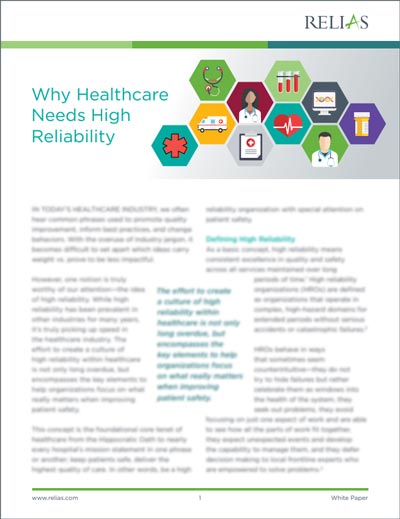High reliability is the foundational core tenet of healthcare from the Hippocratic Oath to nearly every hospital’s mission statement in one phrase or another; keep patients safe, deliver the highest quality of care. In other words, be a high reliability organization (HRO) with special attention to patient safety.
HROs work to create an environment in which potential problems are anticipated, detected early, and nearly always addressed early enough to prevent catastrophic consequences. This mindset is supported by these five characteristic ways of thinking:
- Preoccupation with Failure: Be alert to what could go wrong at any given time by paying attention to small errors (even inconsequential ones) as an indicator that something’s wrong
- Reluctance to Simplify: Never oversimplify explanations for (or disregard) problems, and understand that the work is complex and that not every problem can be anticipated
- Sensitivity to Operations: Stay attuned to the frontline work, while being mindful of the complexity of organizational systems
- Deference to Expertise: Create a culture to defer to the team member with the most knowledge of the issue – often not the member with the most seniority and ensure everyone feels comfortable speaking up, regardless of role or seniority
- Commitment to Resilience: Contain errors and bounce back from them by practicing response to system failures and learning to function despite setbacks
How Did We Get Here?
A pivotal moment in the healthcare industry came in 1999 when the Institute of Medicine published its To Err is Human report, which estimated that 44,000 to 98,000 deaths per year were the result of medical errors. Despite debate on the exact accuracy of these numbers, the report became a major turning point as a wakeup call to improve patient safety. The infamous report is still quoted in healthcare conversations today and even referenced as “The IOM Report” despite its 20+ year history.
The 270+ page report opens with a preface stating, “This report describes a serious concern in healthcare that, if discussed at all, is discussed only behind closed doors. As healthcare and the system that delivers it become more complex, the opportunities for errors abound.”
What’s Missing in our High Reliability Approach?
1. Creating A Just Culture for Patient Safety
Aside from the previously mentioned five characteristics of high reliability, HROs actively create and maintain what’s referred to as a “just culture.” A truly just culture focuses on patient safety through promoting an open and honest environment in which healthcare leaders and workers feel comfortable and safe reporting errors.
The pursuit of a just culture to improve patient safety should be mindful of “improvement fatigue” or “burnout.” Leadership can prevent this, but how? By embedding high reliability as part of the organization’s mission and culture, patient safety efforts and initiatives will naturally fit into “the way we work here” rather than presenting new guidelines or protocols as “just one more thing.” Clinicians were called to care for patients as vulnerable members of society, and preserving their engagement and commitment should be one of leadership’s main priorities.
2. Partnering with Patients
One significant role in the healthcare industry (arguably the most important one) that’s being underutilized in the high reliability journey is that of the patient. As an industry, healthcare workers must shift their thinking to become comfortable with the changing care landscape, as patients are being provided more and more options for services (i.e., the rise in urgent care facilities, competing hospitals, etc.).
3. Demanding Data Transparency
Despite the increased sharing of clinical outcome data for healthcare facilities, such as Leapfrog Hospital Safety Grade and CMS’ Star Rankings, many hospitals aren’t fully on board with transparency of their own data. Providers in particular are frequently hesitant to promote sharing data within their own units and across other units/departments as well.
4. Recognizing the Negative Impact from Misalignment of Payment/Reimbursement Models
Unfortunately, we still have a healthcare system with hospitals and providers largely misaligned on reimbursement. Pay for performance and payor fee schedules and reimbursement models are heavily geared towards generating revenue for the payor or reducing healthcare expenditures. This often compromises the focus on quality, improvement, and patient safety (components of a highly reliable culture).
How Will We Get There?
High reliability is typically described as a journey—an ongoing process rather than a specific structure. To sustain focus on high reliability, organizations must remain diligent and resilient as new threats will always arise and leading problems and challenges will always change.
 As witnessed by healthcare workers and patients alike, it’s evident that despite efforts from major quality organizations (i.e., the Joint Commission and AHRQ), progress to improve patient quality and safety through developing a culture of high reliability is slow, and in some hospitals and health systems completely lacking.
As witnessed by healthcare workers and patients alike, it’s evident that despite efforts from major quality organizations (i.e., the Joint Commission and AHRQ), progress to improve patient quality and safety through developing a culture of high reliability is slow, and in some hospitals and health systems completely lacking.
While many quality organizations (such as the Joint Commission) provide a specific framework for the journey to high reliability, recurring concepts and themes include:
- Commitment from leadership that is evident and influencing throughout all levels of the organization
- Patient safety goals aiming for zero harm
- Standardization of coding and reporting of all adverse events and near misses
- Standardized metrics and tools for monitoring progress
- Creation of a just culture; one that supports a learning organization by promoting accountability, rewarding reporting of events and near misses, and refraining from blaming individuals for making mistakes.

Why Healthcare Needs High Reliability
One notion is truly worthy of our attention and is only picking up speed in the healthcare industry—the idea of high reliability. Download this paper to learn more about high reliability’s history in the healthcare industry, characteristics of high reliability organizations, and challenges with adopting a culture of high reliability.
Download White Paper →





